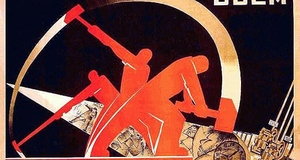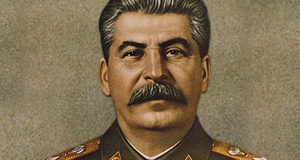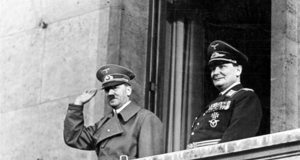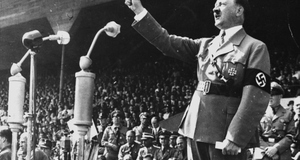Featured Article:Did Stalin Plan to Attack Hitler in 1941? The Historiographical Controversy Surrounding the Origins of the Nazi-Soviet War
By
2015, Vol. 7 No. 11 | pg. 1/2 | »
IN THIS ARTICLE
KEYWORDS
The controversy surrounding the origins of the Nazi-Soviet War in 1941, namely over the issue of whether or not Stalin intended to launch an offensive against Nazi Germany that year, has produced a contentious debate between revisionist (i.e. those who believe that Stalin was preparing for an offensive) and orthodox historians (i.e. those who reject the notion of a soviet offensive in 1941). First popularized by Victor Suvorov, the ensuing debate between orthodox and revisionist historians over Stalin’s intentions in 1941 has produced an abundance of scholarly literature, and it is the purpose of this paper to survey the historiography of this controversy. The debate itself centers around a number of controversies: the nature of soviet foreign policy and ambitions in Eastern Europe prior to 1941; the defensive or offensive character of soviet military preparations from 1939-41 (principally concerning the mobilization and deployment of the Red Army along the German frontier); Stalin’s alleged declarations about the desirability of war against Nazi Germany; and most significantly, the reliability of the various sources that are used by both orthodox and revisionist historians to defend their respective positions. These debates are surveyed in an attempt to show the evolution of the historiography of the origins of the Nazi-Soviet War. In general, I do not subscribe to Suvorov’s thesis, as I believe Suvorov’s premise is founded on a flawed understanding of the nature of soviet foreign policy and on Joseph Stalin’s own ambitions in Eastern Europe.Above all, this paper demonstrates that although the debate over Stalin’s military intentions in the spring of 1941 remains unresolved, it has helped to clarify and expand our understanding of various aspects of soviet history, particulary the nature of soviet foreign policy in the interwar period. Origins of the ControversyThe controversy over whether Stalin intended to attack Hitler in 1941 was first popularized by Victor Suvorov in 1985.1 That Suvorov was able to publish such an interpretation at all is itself extraordinary considering the heritage of soviet historiography. The soviet version of the origins of the Nazi-Soviet War (known in soviet historiography as the Great Patriotic War2) was largely outlined by Joseph Stalin in his radio broadcast to the soviet people on July 3, 1941. In his speech, Stalin asserted that the Soviet Union, a peace loving nation was the victim of a treacherous act of aggression on the part of Nazi Germany, declaring it to be a “perfidious military attack by Hitlerite Germany on our Fatherland.”3 He defended the Soviet Union’s previous policy of friendship with Nazi Germany, declaring that “not a single peace-loving state could decline a peace treaty with a neighbouring state even though the latter were headed by such monsters and cannibals as Hitler and Ribbentrop.”4 The Soviet Union, which had sought merely to maintain friendly relations with Nazi Germany, had been betrayed by Hitler in an attempt to,
Stalin’s monopoly on political and intellectual thought, itself assured by Stalin’s autocratic rule within the Soviet Union, ensured intellectual compliance within the soviet historical community.6 Stalin’s pronouncements, no matter how simplistic or crude, became the ‘leading light of history’.7 Additionally, Stalin and other soviet leaders (such as Zhdanov) intervened directly in the production of historical texts, providing ‘comments’ to guide the study of soviet history.8 The indoctrination of soviet history behind ‘Stalin’s mass-line’ was itself a product of socialist realism. Socialist realism, as defined by Maxim Gorky and implemented by Stalin, viewed ‘culture as coercion’, with writers merely ‘engineers of human souls’.9 The result of this Stalinist interpretation of history was a decline in the standards of soviet scholarship, in which, “the authorities tried to subordinate everything to themselves, and the historians sought to subordinate themselves to the authorities in everything.”10 Revisionist scholars interpret Stalin’s appeasement of Hitler in the early summer of 1941 as part of an elaborate plot to conceal his intentions to launch a pre-emptive strike against him. Suvorov and the Icebreaker ControversyNo discussion on the historiography of the Nazi-Soviet War, and in particular on the controversial issue of whether or not Stalin intended to attack Hitler in the summer of 1941, can be made without first considering the arguments of Victor Suvorov. More than any individual in this debate, Suvorov was responsible if not for originating the claim11, then for popularizing it and giving it the credence as a sound, scholarly alternative interpretation to the orthodox narrative which prior to the mid-1980s dominated the literature on the subject.12 His writings emerged in the context of Gorbachev’s program of perestroika, which freed soviet historians from the shackles of Stalinist ideology.13 Besides allowing soviet historians greater (though far from complete access) to archival documents, perestroika also allowed them greater freedom of interpretation, which was eagerly seized upon by historians such as Suvorov as a chance to deconstruct the soviet myth of the Great Patriotic War. Suvorov’s thesis was simple; Stalin intended to attack Nazi-Germany in the summer of 1941, and therefore rejected the dominant view in western and soviet scholarship on the subject that the Soviet Union was a defenseless victim of German aggression.14 The academic response was swift. Throughout the 1990s numerous conferences, including those hosted by the World History Institute of the Russian Academy of Science and the U.S. Army’s Foreign Military Studies Office, were dedicated to exploring Suvorov’s revisionist thesis.15 Even the journal, Russian Studies in History devoted an entire issue to exploring the controversy in 1997.16 Given his centrality to the whole controversy, and the ferocity of the debate it has unleashed, it is necessary to consider Suvorov’s main arguments at length before proceeding to more specific studies which either critique or support Suvorov’s positions. Suvorov focuses on the mobilization of the Red Army in the months immediately preceding the German attack as evidence of Stalin’s intention to launch a pre-emptive offensive against Nazi-Germany. He points to the movement of numerous Red Army units from the Ural Mountains to the Ukrainian and Belorussian frontier regions.17 Suvorov views June 13, 1941 as being the point at which the Soviet Union effectively decided on war, as he argues that the deployment of troops and material could not be reversed without resulting in serve economic disruption.18 In addition, Suvorov rejects the view that this deployment of soviet reserves along the frontier was a purely precautionary measure. He cites a lack of defensive preparations, such as the construction of fortified lines and anti-tank ditches, and notes their deployment in hidden areas (such as woods) as evidence of the intention of the soviet leadership to conceal an imminent offensive operation.19 Additionally, Suvorov interprets Stalin’s appeasement of Hitler during this period as part of an elaborate plot to conceal his intentions to launch a pre-emptive strike against Hitler, and focuses on the Telegram Agency of the Soviet Union (TASS) directive of June 13, 1941 as indicative of Stalin’s wider campaign of deception.20 Suvorov saw Stalin’s foreign policy as fundamentally rooted to Marxist-Leninist ideology. Viewed from this perspective, Stalin aimed at pursuing ‘world revolution’ and further contended that Hitler was merely an ‘ice-breaker’ in Stalin’s wider plan of spreading soviet rule throughout Europe.21 For Suvorov, this emphasis on soviet expansion can be seen in Red Army military doctrine, which emphasized offensive, rather than defensive, military operations. Soviet Military Planning: Offensive or Defensive?Suvorov is quite right when he notes that soviet military doctrine was predicated on offensive, rather than defensive operations.22 However, I would argue that such a development was not predicated entirely on ideological considerations. True, Marxist-Leninist ideology emphasized human and social agency in history over purely technological developments.23 As such, the soviet high command placed greater emphasis on the rise of mass armies rather than the development of aircraft and tanks as the most revolutionary change in modern warfare.24 In this respect, soviet operational planning developed in opposition to German military doctrine; whereas the latter stressed the necessity of securing a decisive battle through blitzkrieg operations during the opening stages of a campaign, the soviet high command developed the concept of deep-battle, where an enemy would be annihilated in a series of successive offensive operations over potentially a prolonged period of time.25 However, soviet military theorists were also influenced by their own analysis of the battles of the First World War (principally those on the western front), and concluded that the rise of mass-national army’s necessitated a series of decisive battles in order to defeat a modern and industrialized nation.26 As such, it would be incorrect to view soviet military doctrine as simply a reflection of Marxist-Leninist ideology and to conclude that soviet offensive theory necessitated a pre-emptive strike against Nazi-Germany. Most orthodox and revisionist historians of the debate generally agree that the Red Army was mobilized in the months prior to the commencement of Operation Barbarossa, and that roughly 800,000 reservists were called up during this period.27 However, it is the nature (i.e. whether it was primarily defensive or offensive in character) of the Red Army mobilization which is another source of contention between orthodox and revisionist proponents of the debate. Scholars such as Sokolov point to the existence of a concrete plan for offensive operations against Nazi Germany, which stipulated that the, “plans for the defense of the state border', was to be completed by 1 June 1941, in accordance with instructions by the leadership of the People's Commissariat of Defense.”28 Sokolov contextualizes his argument by drawing explicit comparisons between the soviet troop deployments in 1941 with those prior to the ‘Winter War’ with Finland in 1939. In particular, he notes the creation of so-called ‘Polish units’, (which he argues were to be used to ‘legitimize’ the Red Army attack by displaying it as an act of Polish liberation against German rule), in the months prior to the start of Operation Barbarossa.29 Significantly, he draws an explicit comparison to the creation of ‘Finnish units’ in the months prior to the invasion of Finland.30 Sokolov’s also notes the deployment of these ‘Polish units’ along the border regions during the spring of 1941, comparing them to the deployment of the German Wehrmacht along the soviet border, as evidence in support Suvorov’s date of the planned soviet offensive of July 6, 1941.31 More orthodox scholars, such as Glantz and Roberts, concur that the Soviet Union had partially mobilized its forces and had begun to concentrate them along the frontier. However, they view these moves as purely defensive, a precautionary measure on the part of Stalin to guard against the possibility of a German attack and demonstrate soviet strength, but which were ultimately of secondary importance to Stalin’s continued efforts to appease Hitler to buy time for the Soviet Union to rearm.32 Central to this interpretation is their understanding of the incomplete nature of the Red Army’s reform program in the summer of 1941, which orthodox scholars argue inevitably precluded the possibility of an offensive on the part of the Soviet Union that year.33 However, such an argument is predicated on two assumptions; first that Stalin realized that the Red Army was not in a position to launch an offensive, and second that he cared whether or not the Red Army was ready to launch such an attack. Therefore, caution must be applied when attempting to discern Stalin’s thoughts or opinions on the subject of soviet military preparedness. Stalin’s ‘Alleged’ War Speeches and the TASS CommuniqueRevisionist historians cite two speeches allegedly given by Stalin on August 19, 1939 and May 5, 1941 as evidence of Stalin’s expansionist intentions and his desire to ‘sovietise’ Germany and the rest of Europe.34 Both speeches pose a number of problems for historians engaged in the debate given that there is no extant text of either speech (indeed, some witnesses present on May 5, 1941 claimed that Stalin spoke “without a written text”).35 Historians have therefore had to rely on oral recollections of the meetings as well as summarizes of their alleged contents in both the soviet and foreign presses. This is particularly problematic considering the hostility towards oral testimony and memory in the study of history, a product of the professionalization of the discipline during the 19th century in which written sources became privileged as historical evidence.36 As such, there are numerous conflicting accounts of what Stalin actually said and an ever greater number of possible interpretations. There is however, a broad consensus that Stalin spoke of the need to adopt an offensive posture in the near future.37 Uldrick, for instance, believes that Stalin’s May 5th speech was intended to be ‘leaked’ to the press in order to deter a possible German attack.38 Roberts contends that Stalin stressed that there would be no German attack in the immediate future, given that Germany would never repeat the disastrous mistake of fighting a two front-war (in this case against Britain and the Soviet Union) as it had in the First World War.39 Erickson, stresses that Stalin spoke of the possibility of war erupting between the Soviet Union and Germany only in 1942.40 However, revisionist historians such as Weeks argue that Stalin’s speech is evidence of his intentions to launch a pre-emptive attack against Nazi Germany. He noted Stalin’s alleged call for the Red Army to move onto an offensive war footing, while arguing that the ‘leaking’ of the speech was meant to deceive the Germans into a false sense of complacency, rather than as a call to open negotiations.41 A similar problem of interpretation arises when one considers the TASS communique of June 13, 1941. The statement denied that there was any imminent threat of a German invasion of the Soviet Union, and rejected the rumour that Germany was demanding immediate territorial concessions.42 Generally, the TASS communique has been interpreted as indicative of at best the naiveté of Stalin, and at worst his complete incompetence in handling soviet foreign relations during the period immediately preceding Operation Barbarossa.43 Suvorov, however, offers a different interpretation. For him, the TASS communique was merely a rouse designed to lull the Germans into a false sense of complacency while the Red Army completed its preparations for an imminent offensive in the summer of 1941.44 A third alternative interpretation is provided by Roberts. He rejects Suvorov’s interpretation and instead contends that the statement was intended to be an invitation to Hitler to open negotiations with the Soviet Union.45 The issue of interpretation over these two speeches and the TASS communique are but a small sampling of the various opinions regarding the ‘correct’ interpretations of countless texts among scholars involved in this debate. It therefore raises the question; even if the former soviet archives are opened completely, would such access to hitherto classified documents settle the debate definitively? My suspicion is no. Though ultimately speculative, I am inclined to believe that the revelation of further archival materials would serve to merely reinforce, rather than eliminate, both the orthodox and revisionist interpretations of this particular controversy. Such a conclusion is based upon my own conceptualization of the discipline of history, for I view history as essentially an act of interpretation. Facts are only significant when they are given meaning by an individual or by a group. It is the act of linking such facts together into a coherent narrative or argument, and in the process giving such a progression a certain significance, which is at the root of historical inquiry. Carr put the issue quite succinctly when he stated that,
The Nature of Stalin’s Foreign Policy: The Pursuit of World Revolution?Suvorov and other revisionist historians contextualize their claim of Stalin’s desire to attack Nazi Germany in 1941 with an analysis of soviet foreign policy during the 1930s. They contend that Stalin believed in the concept of world revolution, and that the Second World War provided Stalin an opportunity to extend soviet influence throughout Europe. Mel'tiukhov, for instance, asserts that, “the USSR’s principal aim was to expand the “front of socialism” across as much territory as possible.”47 However, this view is rejected, especially by more western historians, who rightly point out that this line of thinking completely ignores the debates over the trajectory of foreign policy within the soviet leadership during this period. It is useful to view this debate within the framework of Zubok and Pleshakov’s framework of a revolutionary-imperial paradigm.48 Though formulated to contextualize soviet aggrandizement in the period after the Second World War, it nevertheless can be applied to earlier periods of soviet diplomacy. Viewed from this perspective, soviet diplomacy was not simply an attempt to initiate world revolution by carrying the Marxist understanding of class struggle outside the borders of the Soviet Union. Rather, it also inherited the legacy of Tsarist imperialism, and should therefore also be seen as an attempt to expand the Soviet Union’s influence and to ensure its security through traditional patterns of great-power diplomacy.49 The question then is not whether Marxist ideology was the dominant force in the soviet diplomacy, but rather in what periods did either revolutionary or imperialist objectives exercise preponderance in the thinking of the Kremlin leadership. On the whole, it must be judged that Stalin’s foreign policy was largely framed around realistic, rather than ideological considerations. This of course is dependent upon the individual scholar’s interpretation of Joseph Stalin. Was Stalin a cold-hearted realist or a radical Marxist-Leninist driven largely by ideology? My own sympathies lie with the former interpretation. That is not to say that Stalin was never motivated by ideological considerations; indeed quite the opposite. Roberts, for instance, in his analysis of the origins of the Nazi-Soviet Non-Aggression Pact of 1939, notes Stalin’s intense suspicion of Britain and France which he attributes to the influence of Marxist-Leninist dogma which viewed capitalism and imperialism as a constant threat to the existent of a socialist state.50 And yet, as Gorodetsky notes, Stalin supported Litvinov’s strategy of collective security in Europe through cooperation with Britain and France throughout most of the 1930s.51 Viewed from this perspective, Stalin was an opportunist par-excellence. This is further evidenced by Stalin’s constant attempts to secure limited spheres of influence for the Soviet Union, either from Nazi Germany or later from the western allies, rather than attempting to extend soviet influence throughout Europe as a whole.52 On the whole, Stalin’s foreign policy can be said to have been motivated primarily by interests of realpolitik, rather than by Marxist-Leninist notions of world revolution. Stalin viewed such blatant aggrandisement as counterproductive, since to do so would deprive the Soviet Union of the assistance and the goodwill of other powers whose cooperation was essential to its own development and security in a hostile world.53 Sources and Political ImplicationsThe nature of the existing sources is another factor to consider when considering the historiography of the origins of the Nazi-Soviet War. Indeed, the harshest criticisms directed against Suvorov’s thesis by orthodox scholars are aimed at the sources that he utilizes. In particular, Suvorov is harshly criticized for his reliance on only soviet sources, to the complete exclusion of German documents.54 Even within this more limited confine, Suvorov relied mostly on published memoirs of former members of the soviet leadership and Red Army general staff, while admitting his omission of official soviet archival material (of which he would not have had much access to at any rate).55 In contrast, proponents of the revisionist school attack orthodox historians with utilizing their sources, in particular soviet publications and archival documents, too literally and pride themselves on a more subtle reading of these texts.56 The controversy surrounding the origins of the Nazi-Soviet War is all the more problematic given the distinct political, rather than simply scholarly, nature of the debate. Koch, in his article focusing on the West-German historiography of the debate, notes this development with barely concealed irritation. In one instance, Koch analyses the work of Gillessen who asserted that Hitler’s attack on the Soviet Union, and more particularly the orthodox interpretation of that attack, allowed Stalin and his successors to paint the conflict as originating purely from German aggression. The ramifications of such an interpretation, at least according to Gillessen, was that the soviet leadership was able to argue that East and West Germany (DDR) owed a special debt to the Soviet Union as a result of the catastrophic losses that it suffered during the war.57 The implication, of course, is that the DDR must cooperate with the Soviet Union to atone for its crimes against a defenceless nation during the Second World War.58 On the other hand, Suvorov’s theory of a Soviet plan for a pre-emptive attack on Germany has been used by some scholars (particularly within the DDR, and after 1990, a reunified Germany) to absolve Germany of its ‘war guilt’.59 Suvorov’s theory has also been embraced by a growing number of Russian historians who utilize it to “cleanse totally the post-communist Russian soul,” by placing the blame for the Great Patriotic War squarely on the shoulders of Stalin and his associates.60 The notion of a Soviet pre-emptive is especially popular in contemporary Russian society, who as Menning notes, “long starved for the truth, believe anything, especially if it seems critical of the former regime and its supporters.”61 However, large segments of former soviet society view such an interpretation as akin to ‘blasphemy’.62 Evidence of the sensitive nature of the debate can be seen in the writings of Mel'tiukhov, who in a preface to one of his articles felt compelled to state that,
The personalized nature of the debate is also evident in the language employed by both orthodox and revisionist historians to critique each party’s respective arguments. By far the harshest lexicon is employed by historians of the orthodox school of thought. Erickson described Suvorov’s thesis as ‘deliberately sensational’, while Menning derided the entire notion of a soviet pre-emptive attack as ‘preposterous’.64 The notion of a Soviet pre-emptive strike is also attacked on the basis that such a concept was originally used by Hitler to justify his attack on the Soviet Union.65 As such, Suvorov’s thesis is attacked as being too politically motivated, and is seen by some historians as merely an attempt to “relieve Nazi-Germany of a significant portion of responsibility for bringing about the Soviet-German War.”66Continued on Next Page » Suggested Reading from Inquiries Journal
Inquiries Journal provides undergraduate and graduate students around the world a platform for the wide dissemination of academic work over a range of core disciplines. Representing the work of students from hundreds of institutions around the globe, Inquiries Journal's large database of academic articles is completely free. Learn more | Blog | Submit Latest in History |


















